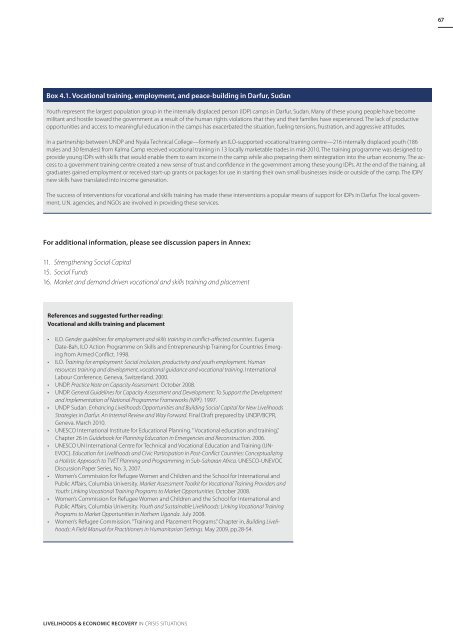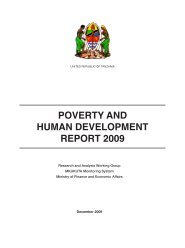Download PDF (4.08 MB) - ReliefWeb
Download PDF (4.08 MB) - ReliefWeb
Download PDF (4.08 MB) - ReliefWeb
You also want an ePaper? Increase the reach of your titles
YUMPU automatically turns print PDFs into web optimized ePapers that Google loves.
67<br />
Box 4.1. Vocational training, employment, and peace-building in Darfur, Sudan<br />
Youth represent the largest population group in the internally displaced person (IDP) camps in Darfur, Sudan. Many of these young people have become<br />
militant and hostile toward the government as a result of the human rights violations that they and their families have experienced. The lack of productive<br />
opportunities and access to meaningful education in the camps has exacerbated the situation, fueling tensions, frustration, and aggressive attitudes.<br />
In a partnership between UNDP and Nyala Technical College—formerly an ILO-supported vocational training centre—216 internally displaced youth (186<br />
males and 30 females) from Kalma Camp received vocational training in 13 locally marketable trades in mid-2010. The training programme was designed to<br />
provide young IDPs with skills that would enable them to earn income in the camp while also preparing them reintegration into the urban economy. The access<br />
to a government training centre created a new sense of trust and confidence in the government among these young IDPs. At the end of the training, all<br />
graduates gained employment or received start-up grants or packages for use in starting their own small businesses inside or outside of the camp. The IDPs’<br />
new skills have translated into income generation.<br />
The success of interventions for vocational and skills training has made these interventions a popular means of support for IDPs in Darfur. The local government,<br />
U.N. agencies, and NGOs are involved in providing these services.<br />
For additional information, please see discussion papers in Annex:<br />
11. Strengthening Social Capital<br />
15. Social Funds<br />
16. Market and demand driven vocational and skills training and placement<br />
References and suggested further reading:<br />
Vocational and skills training and placement<br />
• ILO. Gender guidelines for employment and skills training in conflict-affected countries. Eugenia<br />
Date-Bah, ILO Action Programme on Skills and Entrepreneurship Training for Countries Emerging<br />
from Armed Conflict. 1998.<br />
• ILO. Training for employment: Social inclusion, productivity and youth employment. Human<br />
resources training and development, vocational guidance and vocational training. International<br />
Labour Conference, Geneva, Switzerland. 2000.<br />
• UNDP. Practice Note on Capacity Assessment. October 2008.<br />
• UNDP. General Guidelines for Capacity Assessment and Development: To Support the Development<br />
and Implementation of National Programme Frameworks (NPF). 1997.<br />
• UNDP Sudan. Enhancing Livelihoods Opportunities and Building Social Capital for New Livelihoods<br />
Strategies in Darfur. An Internal Review and Way Forward. Final Draft prepared by UNDP/BCPR,<br />
Geneva. March 2010.<br />
• UNESCO International Institute for Educational Planning. “ Vocational education and training,”<br />
Chapter 26 in Guidebook for Planning Education in Emergencies and Reconstruction. 2006.<br />
• UNESCO UN International Centre for Technical and Vocational Education and Training (UN-<br />
EVOC). Education for Livelihoods and Civic Participation in Post-Conflict Countries: Conceptualizing<br />
a Holistic Approach to TVET Planning and Programming in Sub-Saharan Africa. UNESCO-UNEVOC<br />
Discussion Paper Series, No. 3, 2007.<br />
• Women’s Commission for Refugee Women and Children and the School for International and<br />
Public Affairs, Columbia University. Market Assessment Toolkit for Vocational Training Providers and<br />
Youth: Linking Vocational Training Programs to Market Opportunities. October 2008.<br />
• Women’s Commission for Refugee Women and Children and the School for International and<br />
Public Affairs, Columbia University. Youth and Sustainable Livelihoods: Linking Vocational Training<br />
Programs to Market Opportunities in Nothern Uganda. July 2008.<br />
• Women’s Refugee Commission. “Training and Placement Programs.” Chapter in, Building Livelihoods:<br />
A Field Manual for Practitioners in Humanitarian Settings. May 2009, pp.28-54.<br />
Livelihoods & Economic Recovery in Crisis Situations





